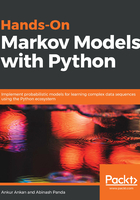
Periodicity
State i is said to have period k if any possible path to return to state i would be a multiple of k steps. Formally, it is defined like this:

Here, gcd means the greatest common divisor (GCD). Basically, k is the GCD of the length/number of steps of all possible paths from state i back to itself. If there are no possible paths from state i back to itself, then the period for it is not defined. We also need to note that k has nothing to do with the number of steps required to return to the starting state. For example, let's say that for any given state the number of steps required to return to it are (4, 6, 8, 12, 16). In this case k=2, but the minimum number of steps required to return is 4, and 2 doesn't even appear in the list of possible numbers of steps.
For any given state in the Markov chain, if k=1, the state is said to be aperiodic. A Markov chain is called aperiodic if all of its states are aperiodic. One major thing to note is that, in the case of an irreducible Markov chain, a single aperiodic state is enough to imply that all the states are aperiodic. Let's take a simple example and check the periodicity of different states:

In the previous example, we can easily see that for state A the possible paths to return are A -> B -> C -> A or A -> B -> C -> D -> E -> C -> A. For these two paths, the path lengths are 3 and 6, respectively, and hence state A has a period of 3. Similarly, B, C, D, and E also each has a period of 3 in the Markov chain, and hence the Markov chain is also periodic:

In this example, we added a couple of extra edges, due to which the possible path lengths for A are now 3, 5, 7, ...; and for B are 2, 3, 4, 5, ... And, since the GCD of these path lengths is 1, states A and B are both now aperiodic. Similarly, we can compute the period of other nodes, each of which is also 1, and hence the Markov chain is also aperiodic.
Let's now add a couple of new methods to our MarkovChain class to compute the period of different states and check whether our model is aperiodic:
def get_period(self, state):
"""
Returns the period of the state in the Markov Chain.
Parameters
----------
state: str
The state for which the period needs to be computed.
"""
return gcd([len(i) for i in all_possible_paths])
def is_aperiodic(self):
"""
Checks if the Markov Chain is aperiodic.
"""
periods = [self.get_period(state) for state in self.states]
for period in periods:
if period != 1:
return False
return True
Let's now try out our methods on our examples. In this example, we will randomly assign probability values to different transitions:
>>> transition_periodic = [[0, 1, 0, 0, 0],
[0, 0, 1, 0, 0],
[0.5, 0, 0, 0.5, 0],
[0, 0, 0, 0, 1],
[0, 0, 1, 0, 0]]
>>> transition_aperiodic = [[0, 1, 0, 0, 0],
[0, 0, 1, 0, 0],
[0.5, 0.25, 0, 0.25, 0],
[0, 0, 0, 0, 1],
[0, 0, 0.5, 0.5, 0]]
>>> markov_periodic = MarkovChain(transition_matrix=transition_periodic,
states=['A', 'B', 'C', 'D', 'E'])
>>> markov_aperiodic = MarkovChain(transition_matrix=transition_aperiodic,
states=['A', 'B', 'C', 'D', 'E'])
>>> markov_periodic.get_period('A')
3
>>> markov_periodic.get_period('C')
3
>>> markov_aperiodic.is_periodic()
False
>>> markov_aperiodic.get_period('A')
1
>>> markov_aperiodic.get_period('B')
1
>>> markov_aperiodic.is_periodic()
True